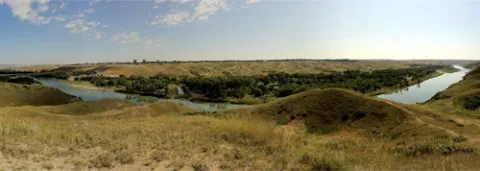Topography and Vegative Cover
The site for the expansion of the City of Lethbridge and the Unversity slopes gradually from a ride near the Oldman River, west of the Unversity site, to the tributary gullies of the Oldman River in the east. The elevation difference between the highest land at the site and the Oldman River is approximately three hundred feet.
The sit e for the university is penetrated by tributary gullies deepened and widened by a progressive erosion cycyle. Native vegetation occurs in the tributary gullies and the prairie land west of the river has been cultivated for cereal crops.
Image

Panoramic view east from the promontory edge of the University Hall site to the Oldman River valley and city plateau.
